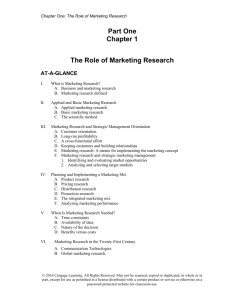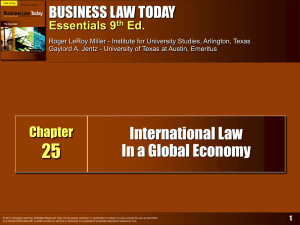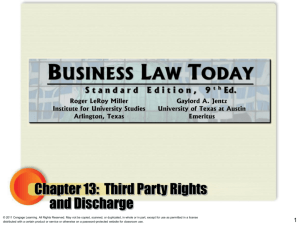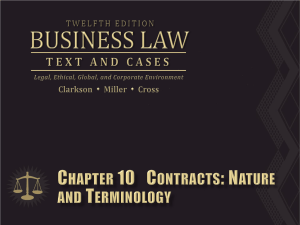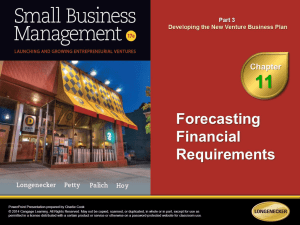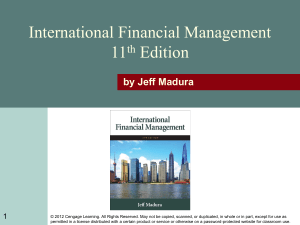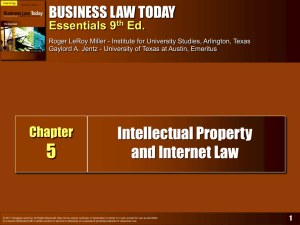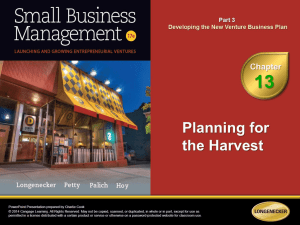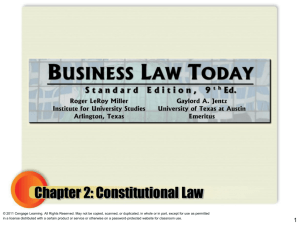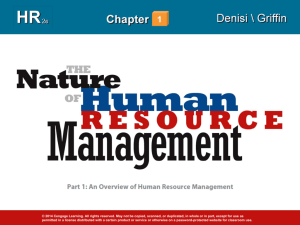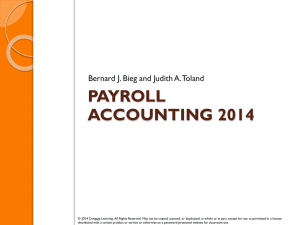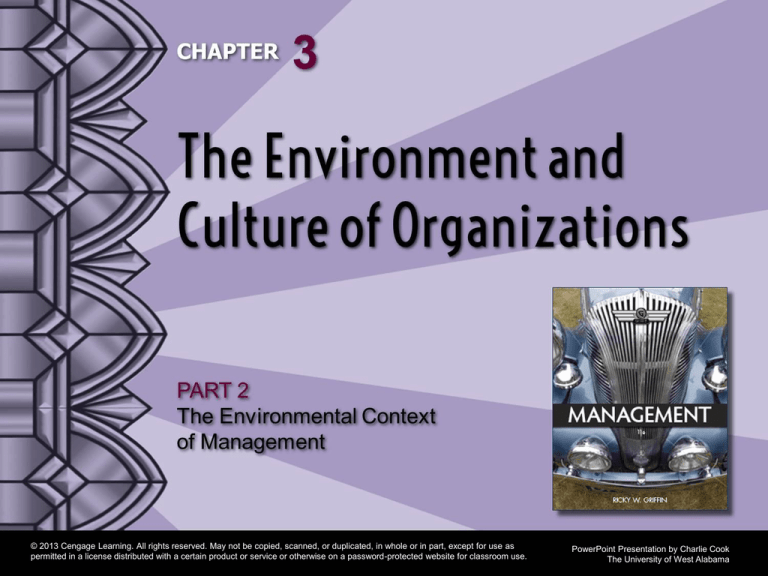
© 2013 Cengage Learning. All rights reserved. May not be copied, scanned, or duplicated, in whole or in part, except for use as
permitted in a license distributed with a certain product or service or otherwise on a password-protected website for classroom use.
PowerPoint Presentation by Charlie Cook
The University of West Alabama
Learning Objectives
1. Discuss the nature of the organizational environment and identify
the environments of interest to most organizations.
2. Describe the components of the general and task environments and
discuss their impact on organizations.
3. Identify the components of the internal environment and discuss
their impact on organizations.
4. Discuss the importance and determinants of an organization’s
culture and how the culture can be managed.
5. Identify and describe how the environment affects organizations
and how organizations adapt to their environment.
6. Describe the basic models of organizational effectiveness and
identify contemporary examples of highly effective firms.
© 2013 Cengage Learning. All rights reserved. May not be copied, scanned, or duplicated, in whole or in part, except for use as
permitted in a license distributed with a certain product or service or otherwise on a password-protected website for classroom use.
3–2
The Organization’s Environments
• External Environment
General environment
Everything outside an organization’s boundaries—economic,
legal, political, socio-cultural, international, and technical
forces.
Task environment
Specific groups and organizations that affect the firm.
• Internal Environment
Conditions and forces present and at work within an
organization.
© 2013 Cengage Learning. All rights reserved. May not be copied, scanned, or duplicated, in whole or in part, except for use as
permitted in a license distributed with a certain product or service or otherwise on a password-protected website for classroom use.
3–3
3.1 The Organization and Its Environments
© 2013 Cengage Learning. All rights reserved. May not be copied, scanned, or duplicated, in whole or in part, except for use as
permitted in a license distributed with a certain product or service or otherwise on a password-protected website for classroom use.
3–4
The External Environment
• The General Environment
The set of broad dimensions and forces in an
organization’s surroundings that create its overall
context.
Economic dimension
Technological dimension
Sociocultural dimension
Political-legal dimension
International dimension
© 2013 Cengage Learning. All rights reserved. May not be copied, scanned, or duplicated, in whole or in part, except for use as
permitted in a license distributed with a certain product or service or otherwise on a password-protected website for classroom use.
3–5
3.2 McDonald’s General Environment
© 2013 Cengage Learning. All rights reserved. May not be copied, scanned, or duplicated, in whole or in part, except for use as
permitted in a license distributed with a certain product or service or otherwise on a password-protected website for classroom use.
3–6
The External Environment (cont’d)
• Dimensions of the Task Environment
Specific groups affecting the organization
Competitors
Customers
Suppliers
Regulators (agencies and interest groups)
Strategic partners (allies)
© 2013 Cengage Learning. All rights reserved. May not be copied, scanned, or duplicated, in whole or in part, except for use as
permitted in a license distributed with a certain product or service or otherwise on a password-protected website for classroom use.
3–7
3.3 McDonald’s Task Environment
Regulators
• Food and Drug
Administration
• Securities and
Exchange
Commission
• Environmental
Protection
Agency
Competitors
• Burger King
• Wendy’s
• Subway
• Dairy Queen
McDonald’s
Strategic Partners
• Wal-Mart
• Disney
• Foreign partners
Customers
• Individual
consumers
• Institutional
customers
Suppliers
• Coca-Cola
• Wholesale food
processors
• Packaging
manufacturers
Internal environment
Task environment
© 2013 Cengage Learning. All rights reserved. May not be copied, scanned, or duplicated, in whole or in part, except for use as
permitted in a license distributed with a certain product or service or otherwise on a password-protected website for classroom use.
3–8
The Internal Environment
• Conditions and stakeholder forces
within an organization
Owners.
Board of directors
Employees
Physical work environment
Culture
© 2013 Cengage Learning. All rights reserved. May not be copied, scanned, or duplicated, in whole or in part, except for use as
permitted in a license distributed with a certain product or service or otherwise on a password-protected website for classroom use.
3–9
The Organization’s Culture
• Organization Culture
Is the set of internal values, beliefs, behaviors,
customs, and attitudes that determines the “feel” of
the organization.
Is not necessarily the same throughout the entire
organization.
Must be managed so that its strength benefits the
firm’s overall effectiveness and long-term success.
Can be dysfunctional if it becomes strongly resistant
to change.
© 2013 Cengage Learning. All rights reserved. May not be copied, scanned, or duplicated, in whole or in part, except for use as
permitted in a license distributed with a certain product or service or otherwise on a password-protected website for classroom use.
3–10
Determinants of Organization Culture
Organization’s
founder
Organization
successes
Organization
Culture
Shared
experiences
Symbols, stories,
heroes, slogans,
ceremonies
© 2010 South-Western, Cengage Learning, Inc. All rights reserved.
3–11
How Environments Affect Organizations
• Environmental Change and Complexity
Change occurs in two ways:
Degree to which change in environment is occurring
Degree of homogeneity or complexity of the environment
Uncertainty
A driving force that influences organizational
decisions.
• Environmental Turbulence
Unexpected changes and upheavals in the
environment of an organization.
© 2013 Cengage Learning. All rights reserved. May not be copied, scanned, or duplicated, in whole or in part, except for use as
permitted in a license distributed with a certain product or service or otherwise on a password-protected website for classroom use.
3–12
3.4 Environmental Change, Complexity, and Uncertainty
© 2013 Cengage Learning. All rights reserved. May not be copied, scanned, or duplicated, in whole or in part, except for use as
permitted in a license distributed with a certain product or service or otherwise on a password-protected website for classroom use.
3–13
Porter’s Five Competitive Forces
Threat of
substitute products
Power of
suppliers
Competitive
rivalry
Power of
customers
Threat of
new entrants
© 2013 Cengage Learning. All rights reserved. May not be copied, scanned, or duplicated, in whole or in part, except for use as
permitted in a license distributed with a certain product or service or otherwise on a password-protected website for classroom use.
3–14
Porter’s Five Competitive Forces
• Threat of new entrants
Extent to and ease with which competitors can enter market.
• Competitive rivalry
Competitive rivalry between firms in an industry.
• Threat of substitute products
Extent to which alternative products/services may replace the
need for existing products/services.
• Power of buyers
Extent to which buyers influence market rivals.
• Power of suppliers
Extent to which suppliers influence market rivals.
© 2013 Cengage Learning. All rights reserved. May not be copied, scanned, or duplicated, in whole or in part, except for use as
permitted in a license distributed with a certain product or service or otherwise on a password-protected website for classroom use.
3–15
3.5 How Organizations Adapt to Their Environments
© 2013 Cengage Learning. All rights reserved. May not be copied, scanned, or duplicated, in whole or in part, except for use as
permitted in a license distributed with a certain product or service or otherwise on a password-protected website for classroom use.
3–16
How Organizations Respond
to Their Environments
• Information Management in Organizations
Boundary spanners
Environmental scanning
Information systems
• Strategic Response
Maintaining the status quo, altering the current
strategy, or adopting a new strategy.
• Mergers, Acquisitions, Alliances
Firms combine (merge), purchase (acquisition), or
form new venture partnerships or alliances.
© 2013 Cengage Learning. All rights reserved. May not be copied, scanned, or duplicated, in whole or in part, except for use as
permitted in a license distributed with a certain product or service or otherwise on a password-protected website for classroom use.
3–17
How Organizations Respond to
Their Environments (cont’d)
• Organizational Design and Flexibility
Adapting by building flexibility into structural design.
Mechanistic firms operate best in stable environments.
Organic firms are best suited for dynamic environments.
• Direct Influence of the Environment
Attempting to change the nature of the competitive
conditions in its environment to suit its needs.
Pursuing new or changed relationships with suppliers,
customers, and regulators.
© 2013 Cengage Learning. All rights reserved. May not be copied, scanned, or duplicated, in whole or in part, except for use as
permitted in a license distributed with a certain product or service or otherwise on a password-protected website for classroom use.
3–18
The Environment and
Organizational Effectiveness
Models of Organizational
Effectiveness
Systems resource approach
Internal processes approach
Goal approach
Strategic constituencies approach
Combined approach
© 2013 Cengage Learning. All rights reserved. May not be copied, scanned, or duplicated, in whole or in part, except for use as
permitted in a license distributed with a certain product or service or otherwise on a password-protected website for classroom use.
3–19
3.6 A Model of Organizational Effectiveness
© 2013 Cengage Learning. All rights reserved. May not be copied, scanned, or duplicated, in whole or in part, except for use as
permitted in a license distributed with a certain product or service or otherwise on a password-protected website for classroom use.
3–20
3.1
Examples of Admired and High-Performing Firms
Fortune’s
Most Admired Companies (2011)
Business Week’s
Best-Performing Companies (2011)
1.
Apple
1.
Priceline.com
2.
Google
2.
Intuitive Surgical
3.
Berkshire Hathaway
3.
Southwestern Energy
4.
Southwest Airlines
4.
Apple
5.
Procter & Gamble
5.
salesforce.com
6.
Coca-Cola
6.
Express Scripts
7.
Amazon
7.
Flowserve
8.
FedEx
8.
FMC Technologies
9.
Microsoft
9.
Cliff’s Natural Resources
10. McDonald’s
10. Amazon.com
© 2013 Cengage Learning. All rights reserved. May not be copied, scanned, or duplicated, in whole or in part, except for use as
permitted in a license distributed with a certain product or service or otherwise on a password-protected website for classroom use.
3–21


